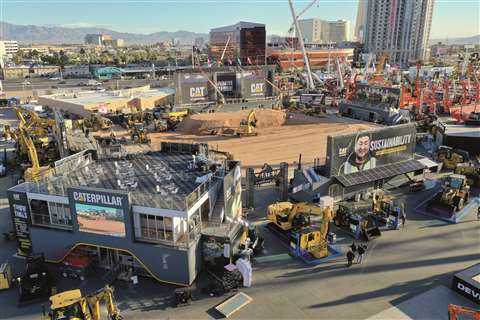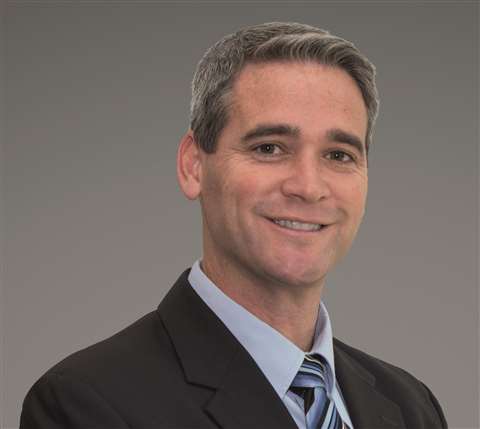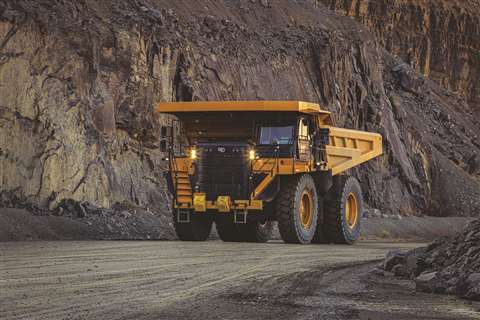Interview: Caterpillar executive on electric power, automation and new equipment
24 May 2023
 Caterpillar had one of the largest stands at ConExpo
Caterpillar had one of the largest stands at ConExpo
ConExpo is North America’s largest construction trade show and Caterpillar, the world’s largest construction OEM, is headquartered in North America – I was expecting the Caterpillar stand at the show to be busy but, even so, the number of people was surprising. It was like being back on the London underground during rush hour, rubbing shoulder to shoulder with people.
I met Jason Conklin, senior vice president of Caterpillar with responsibility for Global Construction and Infrastructure, at the company’s stand, thankfully in a private room upstairs, where he was relaxed and accommodating, even offering to skip his lunch to give us more time to talk.
Conklin splits his time between his team, dealers and customers, and says that in his role he has travelled to more than 80 countries and all 50 States in the US. He says that the lack of skilled workers is, “the number one thing we hear from every single customer we talk to all around the world.”
The crowds at the Caterpillar stand are a reminder of the position that the company holds in the industry. They have consistently topped International Construction’s Yellow Table, the annual ranking of the world’s biggest OEMs by sales. When Caterpillar talks the industry takes notice, which is one of the reasons that the OEMs stance on alternative power – arguably the hot topic right now – is of such interest.
On this issue Conklin says, “We have to work all angles; we have to be there for the lithium-ion battery, we want to do research on hydrogen combustion, we’re looking into hydrogen fuel cells, but maybe most importantly, we’re making our current diesel machines more fuel efficient and more sustainable for the future.”
Regarding battery powered equipment, Caterpillar announced last year four electric prototypes – the 301.9 mini excavator, 906 compact wheeled loader, 320 medium excavator and a 950 GC medium wheeled loader. All run with lithium-ion batteries. Regarding electric power specifically, Conklin says that Caterpillar, “definitely see government requirements coming to potentially incentivize its adoption.”
How to make construction more sustainable
As Conklin says, Caterpillar – and indeed all major OEMs – need to “work all angles” when it comes to alternative power sources as no OEM or engine manufacturer can confidently say exactly what the future will look like.
One thing that Conklin is keen to point out though is how much cleaner and sustainable diesel equipment is now, and how that journey is ongoing. The company is committed to ensuring that every new product it introduces is more sustainable than the machine it replaces.
“If we’re able in some cases to improve our fuel efficiency, reduce our fuel burn by 35% versus machines ten years ago, that means less carbon,” says Conklin. “Our view is that diesel equipment also needs to be more and more sustainable. We’re proud of what we’ve done to increase our fuel efficiency.”
 Jason Conklin, senior vice president, Caterpillar, with responsibility for Global Construction and Infrastructure
Jason Conklin, senior vice president, Caterpillar, with responsibility for Global Construction and Infrastructure
Caterpillar has gone public with its sustainability goals – the company says that it is committed to a 30% reduction by 2030 in terms of absolute greenhouse gas (GHG) emissions that it produces in operations. Conklin calls this a “pretty bold goal” but says that, since 2006, Caterpillar has already reduced GHG emissions in its operations by around 50%.
One of the ways that GHG can be reduced is through increased productivity and efficiency and a key way to achieve this is through technology. Caterpillar has introduced a new version of VisionLink that brings together multiple legacy solutions that were built on different platforms with fragmented interfaces. The OEM says that it has consolidated those capabilities into a single solution that is scalable for customers of all sizes and available in both a desktop and mobile experience.
VisionLink allows users to access their data, manage their fleets, schedule tasks and provides key metrics, location of assets, fuel level, idle time and more. It also, crucially, allows its users to manage equipment and attachments, regardless of their brand.
“It’s full fleet. We started out originally thinking that VisionLink would be more of a Caterpillar application for Cat assets,” reveals Conklin. “But the more we talked to customers, they said ‘wait a second, I’ve got multiple trucks, attachments, I’ve got competitive iron.’ We want to make sure that VisionLink can meet all those needs.”
Platforms such as VisionLink will certainly play a key role in construction’s sustainability journey, as will automation. Construction is relatively early on its path to autonomy and is certainly behind mining.
“We’ve been on a long journey with mining – in fact, our machines have moved over 5.5 billion metric tons autonomously. And we’ve done that across 25 mine sites. What we’re most proud of – of course we’re helping improve productivity – is we’ve done it without injury from autonomy,” says Conklin. “That tells you about the power of autonomy; it helps your safety, it helps your productivity.”
 Caterpillar has a collaboration with Luck Stone to scale autonomous solutions
Caterpillar has a collaboration with Luck Stone to scale autonomous solutions
Autonomy in the construction industry
Caterpillar is closely collaborating with Luck Stone, the US’s largest family-owned and operated producer of crushed stone, sand and gravel, to deploy Caterpillar’s autonomous solution to its Bull Run plant in Virginia, US. This will be Caterpillar’s first autonomous deployment in the aggregates industry and Conklin says that the partnership will deepen their understanding of autonomy operations for sites with fewer mobile assets and inform scaling the technology into construction.
“This project allows us to accelerate our learning and brings what we’ve learned from mining down into the quarries. From there, we see applications such as paving being a logical next step, automating machines like soil compactors, asphalt compactors.”
Conklin says that there is a “long road to autonomy” but that the potential is there. “We start by making some features in our machines autonomous. And then we go to a Cat Command remote control solution where the operator’s actually off the equipment but running it.
“Then there’s full autonomy, which some customers are ready for, and some aren’t, but we certainly have the experience to leverage it when the industry’s ready.”



